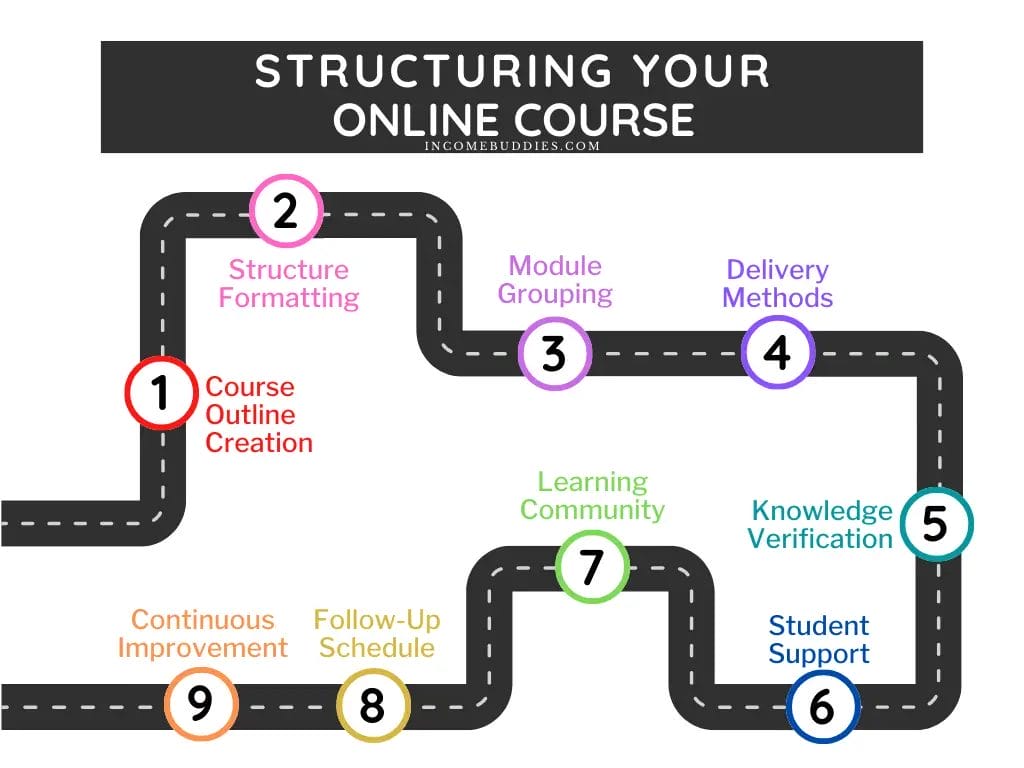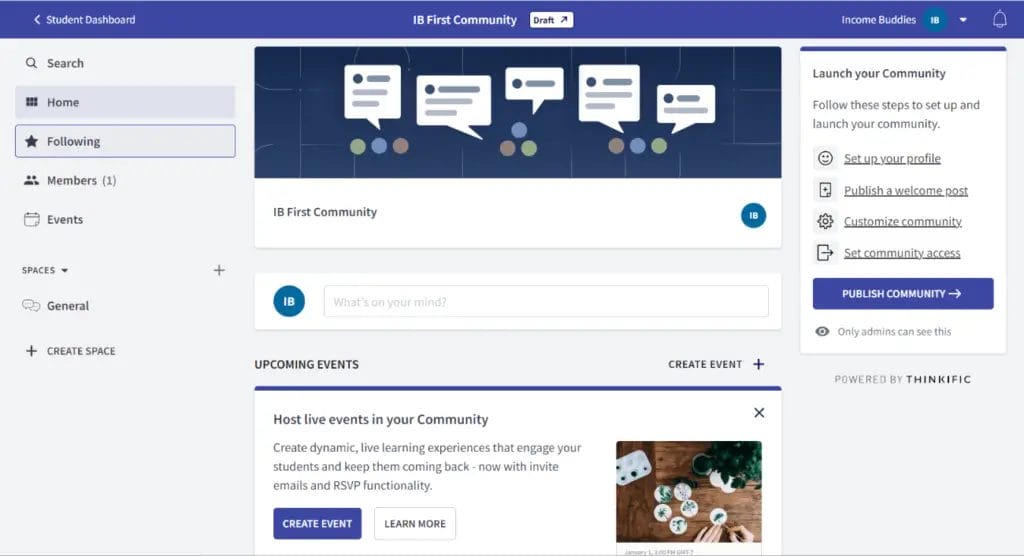How to Structure Your Online Course (Step-By-Step Guide)
“Want to create a course online that will keep your learners engaged and complete your course?”
To create an high-quality online course that sells, you’ll need to know how to,
- Choosing the right course topic
- Get started on the right course platform
- Design the right course structure
Without a logical flow of thoughts, ideas and concepts, students will look elsewhere for their online education, a major mistake that many course creator make.
KEY TAKEAWAYS
- Clear course outline is essential for effective course structure that group lessons into modules.
- Course delivery is highly dependent on the type of course you are teaching, however knowledge verifications is required regardless of the type of course you are conducting.
- Student support and establishing a community of learning makes your course unique, and scheduling personalized follow-ups can keep your learners motivated to attend your course.
Creating and delivering your online course content through top online course platforms, having the right LMS system to let you structure and style your online platform according to your course needs is key to creating a successful online course business.
How To Structure Your Online Course Effectively as Course Creators

To be successful as an course creator, you’ll need to learn how to create a course outline template that is designed according to your course topic that works for you and your students.
Setting up an online course in a logical flow that will keep your students engaged isn’t as difficult as you think.
Here is a list of key steps you’ll need to take to structure an online course effectively. The steps will include:
- Creating an outline for online learning,
- Course structure format,
- Delivery of online course material,
- Devising knowledge checks
- Developing ways to offer your students support,
- And many others…
Depend on how complex and involved your online course, you can change things as needed to provide the best learning experience for your students.
1. Create a Course Outline
The very first thing you have to do is to create an outline which is a course plan for your online course.
- Create an module structure of the course
- Organize your content logically
Module structure of the course
Module of the course will take in the form of a hierarchy using Roman numerals, letters and numbers.
The reason why roman numerals, letters and numbers are used instead of just either of them is to help you differentiate the different level of hierarchy when designing your course plan.
Generally, the module structure of the course follows the following hierarchy:
- Modules are generally represented by roman numerals. Within a module there will consist of a few lessons.
- Lessons are generally represented by letters. Within each lessons there can have some learning activities.
- Learning activities are generally represented by numbers. Learning activities includes lectures in the form of videos, slides/ presentations, assignments, quiz, online discussions, and additional resources.
Breaking it down to smaller pieces the hierarchy gives you an overview of the whole course.
Organize your content logically
The content of your course should be organized logically. It should be lay out in such a way that it takes you from very basic concepts to the more difficult until the very end of the course.
The logical flow of the course content helps to make the course easy to digest.
And a great tip to help you structure your online course is to outlining your course before you start creating any online content for your course.
This way, you will know how you want to set up your online course before you put in all the handwork creating the contents.
Here is an example of how the course outline should be structured.
Online Course Outline (Example)
The main takeaway of an course outline is to give an one line description to describe the ideas and concepts you want to cover. The follow example features how to make the perfect cup of Japanese-style (or iced) pour over coffee. This isn’t a full layout, but it should give you a good idea.
Course Title: Making Japanese-Style Coffee
- I. Gathering Necessary Equipment
- A. Pour Over Devices
- i. specifically designed high-end models
- a. Chemex, Hario, Mellite and etc.
- ii. makeshift options
- a. an old percolator carafe
- b. glass, ceramic and stainless steel vessels
- i. specifically designed high-end models
- B. Ice Trays
- i. know how much water each compartment holds in the tray for perfect measuring
- C. Coffee Grinder
- i. allows control over grind consistency
- ii. select between burr or herb grinder: which is best?
- D. Gooseneck Kettles
- i. avoid electric kettles or ones with a short spout
- E. Funnels ; Filters
- A. Pour Over Devices
- II. Selecting the Right Beans
- A. Single Source
- B. Store Bought
- C. Whole Beans Only
- i. best flavor
- III. Determining How Much to Make
- A. Single
- i. ¾ cup ground coffee per three cups boiled water and one cup ice
- B. Up to Three People
- i. 1 cup ground coffee per four cups boiled water and two cups ice
- C. More than Three People
- i. adjustments for a coffee party
- ii. quickly making batches of pour over coffee
- A. Single
- IV. Measure Ingredients
- A. Scales versus measurements
- B. The importance of measuring water and ice
- V. Preparing ; Making the Coffee
- A. Boil water only to 180°F
- B. Pour in slow circular motions with small amounts of water
- VI. Final Steps
- A. Wait for 10 minutes after pouring all water
- B. Stir the grounds and press moisture out
2. Format the Course Structure
There are many online course formats online course creators can adopt when you create your course. Each have their own merits.
When you make your course, you can organize your course in many ways, but the ones mentioned below are some of the more popular and common.
Just remember, you are under no obligation to use them unless you feel they’ll work best for your type of content.
- Step by Step: If you’re going to teach a course about something like cooking, painting or car repair, then offering a course that goes one step after the other will be ideal. Step by step course offers a guided process where your students can feel the most engaged and suitable for both simple and complex course topics. You can create the material ahead of time and students can learn at a pace convenient to them.
- Week to Week: Formatting your course structure on a weekly basis means you can adjust the lesson plan according to the speed in which the class grasps the material. This is good for teaching things like yoga, math, science or novel writing.
- Monthly: Releasing a new lesson each month is good for more complex subject matter where there’s a lot to review and mentally digest. It gives students time to read and reread material while applying it to exercises and practice. Such a setup is good for online courses that feature phytochemistry, gardening or accounting.
- Class by Class: If your online course is going to involve teaching people on an individual basis, then you can set the structure to deal with it as you schedule the class. This means you’ll devise a very rough and loose outline for things like dance, music and reading.
- Reference: This offers a curated collection of information, material and content that students can pick through and study as they wish. Such a thing is good for hands off teaching without a regular class setup. So, you’ll want to use it for things like herbalism, ancient history or mythology, for example.
Depending on the different type of course and online course topic you are offering to your students, the suitable format and the course structure may vary.
Structure an online course effectively according to your student’s learning goals is key to keep your students engaged and provide quality online learning experience.
If you’re unsure of which course structure should you choose, here is a guideline I’ve created for you to get started:
- On-Demand Online Course: The best way to structure your online course that is delivered through self-paced training will be “Step by Step”.
- Live Online Course: The best way to structure your online course that requires live class will be “Class by Class”.
Creating and selling your online course at the right online course platform will allow you to choose ow switch between different course format easily.
If you are wondering which is a good platform to start, check out my article on the best online course platform for course creators after this.
3. Group Lessons into Modules
With the course outline you devised earlier, group your lessons into easy to digest modules.
While you have separate hierarchies for each item on the outline, you don’t necessarily have to present these one by one.
Just match every lessons and modules so it flows in a cohesive and logical manner.
The idea is that you want the titles to be descriptive, memorable and concise.
Once you’re done, go and ask a friend to review the titles for you and see if they have recommendations to make them better.
4. Course Delivery

The next consideration here is to decide on how you want to deliver the material to potential students. The best is to use a combination of the methods listed below.
- Video: This is the most common and best way to teach a lesson. You can explain exactly what you mean and which precise concepts you want to students to understand. Plus, it’s the best way to deliver a step-by-step concept for things like cooking or herbalism.
- Text: Having something written in black and white is the best way for students to retain information. They’ll be able to refer to it whenever they need and it will document the basic precepts you want them to learn.
- Live Classes: Doing a livestream or webinar is a great way to present information. These will be in real time, which allows students on the spot interaction with you and other students. You can record these so people can review them later.
- Private Lessons: Using something like Skype is great for one-on-one learning or for teaching a small group. It gives personalized attention to each student and you don’t have to parse out your lesson plan. This gives some flexibility while allowing for adjustment according to how quickly the students are learning the material.
Depending on your format and the kind of class you’re planning to teach along with the platform you use, your course delivery may varies.
5. Setup Knowledge Verifications
Because some subjects will require the students to verify their knowledge before moving onto another lesson, you’re going to have to create things like exams, tests, quizzes and other types of checks.
While you don’t have to create something that’s akin to college, it should cover the basics of the material taught.
Most top eLearning platforms will have a way for you to create these.
Knowledge verification is the best way to evaluate their learning outcome.
Evaluating the Learning Outcome
Tests, quizzes, assignments and exams are the best ways to assess your learner’s knowledge.
For simple topics, some simple assessment will often do the trick.
- Simply having them present a basic assignment or filling out a worksheet will do the trick.
For more complex topics such as yoga or car repair, then some kind of more in-depth knowledge check will be essential.
- You want to ensure students are exercising proper safety protocols, have a command of the terminology and execute techniques the correct way.
- You may also want them to turn in a short video of their performance.
6. Create Student Support
One of the best learning tools you can offer your students is a vast amount of support for which they can use at their disposal.
Make yourself contactable by your learners by:
- Giving your students access to your social media pages
- Send them your work email address so they can contact you
- For some cases, five them your phone contact so they can call you and ask questions (I will probably avoid this as it is very time consuming)
You may want to devise ways for students to interact with each other.
Having various ways students can get support illustrates to them that you’re serious about helping them learn the subject and that they’re getting the most for their money.
Make your course into a community by:
- Create a chat room (on your chosen platform and on places like Discord)
- Forum pages or a place to post questions
- Form groups using social media
- Have study groups on livestreams or webinars
- Create extra credit worksheets or other supplemental information
- Reference course
- Networking capabilities with others in the field or industry on the subject you’re teaching
- Publicize reviews, comments and feedback for individual lessons
7. Institute a Community of Learning

Aside from creating student support, you want to establish a wider learning community.
This can involve other teachers with their students or be an elite circle of all your students at every level of the learning process.
Not only will it create a buzz to attract more students to your online course, it will promote a sense of belonging for current students.
Using online membership platforms are excellent for creating this kind of community.
This will still involve learning the subject matter but it will also provide another means for deeper understanding.
8. Schedule Follow-Ups
Finally, you want to come up with a schedule to follow-up with each student in a personal way.
This is ideal since many students can feel disconnected and isolated in an online education situation. If it becomes too much or too overwhelming, some students may fall to the wayside due to lack of motivation.
How to Schedule Your Follow-up?
You can do this once a week or monthly, whenever is most convenient for you.
But, you should make a point to speak directly with each one of your students
- Set up a live online meeting with your students.
- Send survey for feedbacks on the course.
- Send them email or instant message to talk about what they think about the course.
Ask them what they think about the course, how they feel about the material and what items are confusing to them.
The most important component here is that you need to listen to what they have to say.
Take praise and criticism with equal consideration, noting what all your students say.
9. Continuous Improvement
Adjust your course structure according to all the feedbacks you get from your students and keep improving on your course.
You goal here is to,
- Make your course more valuable for your students
- Make your course more engaging for your students
- Make your students more incline to complete your course
Keep improving you course and measure your course success with the various metrics such as engagement rate, course completion rate, reviews etc.
Why Is Course Structure Important In Learning?
With a good course structure, as a course creator, you’ll be able to adopt the same exact structure and course format to create your next course and module.
- Saves you time and energy in creating your library of online course for your online school.
- Greatly increasing the success rate turning your online education business profitable.
An online course structure that is organized in a logical flow according to how the learners progress through the course can help your students meet the learning goal of the course faster.
Depending on your course structure, you can monetize your course differently.
Unfortunately, many course creators make the mistake of jumping into edupreneurship without understanding the importance of the structure and design during course creation.
Edupreneur both new and experienced often create an online course that lacks a proper course structure.
- No logical flow of your course material
- Absence of required features for engagement
- Missing post sales follow-up of the online course
Structuring your content the right way will keep your students engaging online for longer period of time, making the learning experience productive.
Is It Hard To Structure An Online Course?
Structuring an online course that effectively teaches your students depends on the following:
- Types of course topic
- Complexity of the course topic
- Delivery mode of your online course
Depend on how complex and involved your online course, your course structure can varies, but all should follow these general steps in structuring your online course.
- Basic Course: Structure for entry-level course, free course and short course are generally easy, as these type of course can can be delivered through self-paced online course content.
- Advance Course: Structuring advanced course, masterclass and certain course topics such as course that teaches communication skills and presentation skills might requires a variety of course delivery such as live training, 1-on-1 sessions, or group online classes.
What I Think About Structuring An Online Course?

Structure helps you in every stage of making your online course. A great structure sole goal is to effectively deliver the course’s learning objectives.
Many people today are willing to pay for a course where they can learn the skills and knowledge online.
52% of college students in the U.S. feels that online education gives a better learning experience than their classroom education.
An online course that is structured well can promote more students to join your course helping you to find success as an edupreneur, while educating the public worldwide.
Learning how to structure your course correctly can make your course,
- Look more professional
- Feel more engaging
- Improve overall learning experience
In additional, your course should also have an enticing title, an engaging course description and a stunning cover photo that makes your course clickable and discoverable by your audience.
- 7 Best Teachable Alternative for Course Creators (Free and Paid)
- LearnWorlds Features: In-Depth eLearning LMS Overview
- ThinkiFic Features: Course Creator’s In-Depth Overview
- +59 Best Proven Membership Site Ideas to Get Started This Year (Read First)
- Passion.io Review 2024: Still The Best App For Coaches & Creators? (Limited Time Lifetime Deal)
Join 900+ BUDDIES who are growing their wealth with our weekly Income Newsletter
Join 900+ BUDDIES who are growing their wealth with our weekly Income Newsletter
Antony C. is a dividend investor with over 15+ years of investing experience. He’s also the book author of “Start Small, Dream Big“, certified PMP® holder and founder of IncomeBuddies.com (IB). At IB, he share his personal journey and expertise on growing passive income through dividend investing and building online business. Antony has been featured in global news outlet including Yahoo Finance, Nasdaq and Non Fiction Author Association (NFAA).

